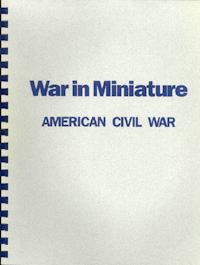| Brief Description |
These rules put the players in the roles of corps commanders, typically commanding
two divisions per player. A key innovation is the distinction between morale and
troop effectiveness. Each turn is composed of a variable number of impulses (combat phases),
influenced by initiative. Units are controlled by orders, which may be tactical or
operational. Officers are rated for competence and initiative. Ammunition use is factored
into a general Fatigue system. All units have the same base morale rating,
but these are adjusted due to leadership. Booklet also provides extensive leadership ratings
for historical officers, plus a representative TO&E for the Union and Confederate armies
in 1862/3.
|
|---|
| Period | American Civil War |
|---|
| Scale | One infantry or cavalry figure represents 100 men; one
gun represents 2 guns.
One tactical impulse represents 20 minutes. The ground scale is 1" = 100 yards, with a height
scale of 1" = 20 yards. Designed for use with 15mm figures, but conversions
are given for 6mm, 9mm, and 25mm scales. |
|---|
| Basing |
| Troop Type | # of figures | base size
(frontage x depth) |
|---|
| Infantry | 3-4 | 1" x 3/4" |
| Cavalry | 2 | Standard | 1" x 1" |
| Western cavalry 1863+ | 1 1/2" x 1" |
| Artillery | 1 gun | 4-gun unit | 3/4" x 1 1/2" |
| 6-gun unit | 1" x 1 1/2" |
|
|---|
| Contents | 56-page spiral-bound rulebook; two 8.5" x 11" reference cards |
|---|
| Designer | Michael R. Childers |
|---|
| Publisher | First edition published 1993 by Mage |
|---|

